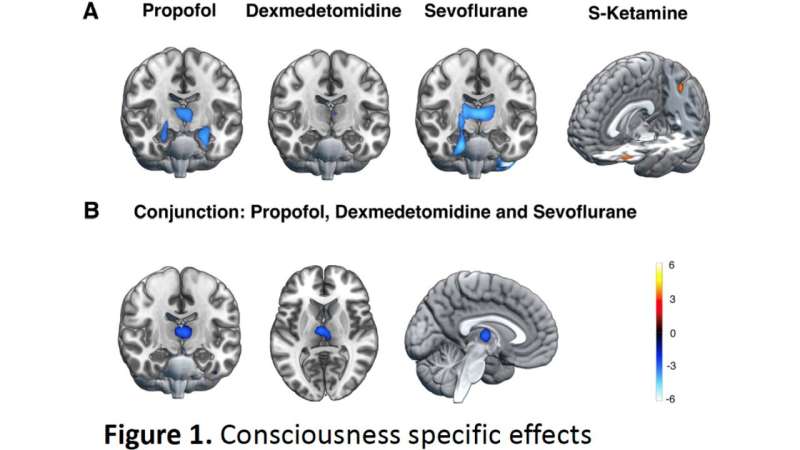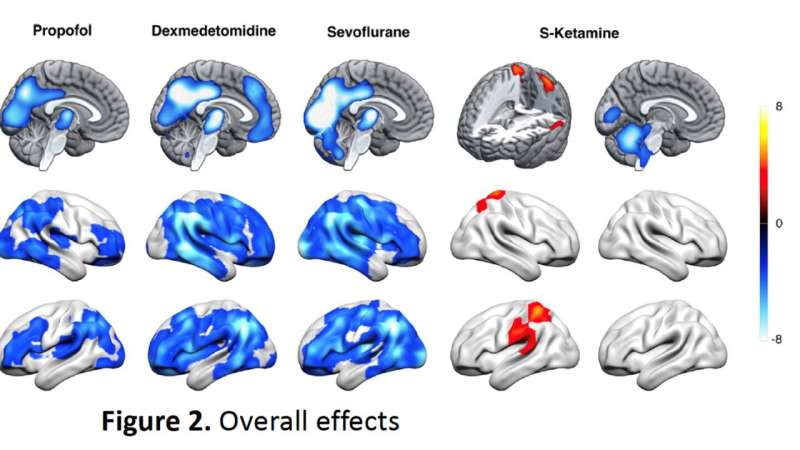This article has been reviewed according to Science X's editorial process and policies. Editors have highlighted the following attributes while ensuring the content's credibility:
fact-checked
peer-reviewed publication
trusted source
proofread
Decreased thalamic activity is a correlate for being asleep: Study investigates neural mechanisms of anesthetics

In a study conducted at the University of Turku, Finland, the neural mechanisms of different anesthetics were investigated using functional brain imaging. Disconnection from external world and events ("sleeping") was specifically related to reduced activity in the central thalamic nuclei in subjects who received propofol, dexmedetomidine or sevoflurane, but not in subjects who received S-ketamine.
The neural mechanisms of general anesthetics, which cause changes in consciousness and responsiveness, are not completely understood. Previous studies have mainly investigated the differences in brain activity between unmedicated wakefulness and the unresponsive state induced by anesthesia. However, the challenge has been to identify the changes in brain activity that are specifically related to changes in consciousness, and to distinguish them from the other effects of the anesthetics.
The study was carried out at Turku PET Center as a joint effort of two research groups at the University of Turku, Finland. The main goal was to find out which changes in the metabolic activity of the human brain are related to the inability to experience and react to external stimuli, i.e. to the so-called disconnected state. The work is published in The Journal of Neuroscience.
"The key point of our research is related to a novel experimental setup. In collaboration with Professor Michael Alkire of the University of California, UCI, we designed a study that enabled correlating changes in brain activity with changes in the state of consciousness," says Docent Harry Scheinin, the Principal Investigator of the study.
Healthy subjects were randomly assigned to receive either propofol, dexmedetomidine, sevoflurane, S-ketamine, or a placebo, and brain metabolic activity was measured with positron emission tomography (PET) imaging.

The doses of different anesthetics were chosen so that about half of the subjects in each group would retain, and half would lose, their ability to respond. All subjects in the same drug group received the same dosage of the anesthetic, and by comparing the differences in brain activity between responding and unresponsive subjects, as well as between the drugs and the placebo, the researchers were able to relate the observed differences more precisely to the difference in the state of consciousness. To ensure the disconnected state in the unresponsive subjects, they were carefully interviewed immediately after waking up.
"By studying four anesthetics with different mechanisms of action in a comparable experimental setup, we aimed to find possible similarities and dissimilarities in their brain effects. Including the placebo group enabled us to also examine the overall effect of anesthetics in the same experiment," says Doctoral Researcher Oskari Kantonen, the first author of the publication.
The disconnected state was specifically related to the reduced activity of the central thalamic nuclei in subjects who received propofol, dexmedetomidine or sevoflurane (Figure 1, blue color). Instead, the overall effects of the drugs were seen as widespread changes in the cerebral cortex (Figure 2). In particular, the findings related to the state of consciousness were clearly more limited. Unlike the other drugs, the disconnection with S-ketamine appeared to be associated with increased activity in the left parietal cortex (Figure 1, orange color).
Although reduced activity of the thalamus has already previously been linked to the effects of most anesthetics, it has been unclear whether the reduction is specifically related to a change in the state of consciousness or to other effects of anesthetics. Based on the findings of the present study, the reduced activity of the thalamus seems to play a key role in maintaining the disconnected state during anesthesia when using propofol, dexmedetomidine or sevoflurane.
"S-ketamine is known to be a very different anesthetic, but an interesting new finding was that its regional brain activity effects related to the state of consciousness also differ so clearly from other anesthetics," Dr. Kantonen adds.
The study is a continuation of work published in 2020, in which a different experimental design was applied.
More information: Oskari Kantonen et al, Decreased Thalamic Activity Is a Correlate for Disconnectedness during Anesthesia with Propofol, Dexmedetomidine and Sevoflurane But Not S-Ketamine, The Journal of Neuroscience (2023). DOI: 10.1523/JNEUROSCI.2339-22.2023



















